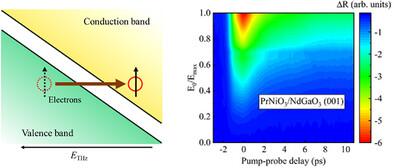仅控制电荷自由度的太赫兹驱动稀土镍酸盐的超快动力学
IF 19
1区 材料科学
Q1 CHEMISTRY, MULTIDISCIPLINARY
引用次数: 0
摘要
理解强相关系统的微观物理学和增强其技术潜力的一个重要策略是有选择地将基本自由度从平衡中驱动出来。光子能量为几兆电子伏的强太赫兹(THz)脉冲不仅可以满足这一目的,而且可以揭示它们的电子和量子性质。在这里,我们展示了太赫兹驱动的稀土镍酸盐(RNiO3, R =稀土原子)的超快动力学-一个研究莫特绝缘体-金属转变(IMT)的原型系统。Mott绝缘态的太赫兹驱动通过价电子穿过带隙的量子隧穿诱导瞬时IMT,而相关金属态的太赫兹驱动导致传导电子的整体加热。在这两种状态下,激发电子的后续弛豫分别通过两步过程(电子-声子热化和电荷有序绝缘状态的恢复)和一步过程(电子-声子散射)发生。特别是电子的弛豫动力学和声学声子模式的缺失,表明太赫兹诱导动力学的纯电子和高度非热性质,主要由电荷自由度控制。这种太赫兹诱导的IMT可以在光电子学中找到其应用,具有增强的性能和最小的器件尺寸和散热。本文章由计算机程序翻译,如有差异,请以英文原文为准。

Terahertz-Driven Ultrafast Dynamics of Rare-Earth Nickelates by Controlling Only the Charge Degree of Freedom
An important strategy for understanding the microscopic physics of strongly correlated systems and enhancing their technological potential is to selectively drive the fundamental degrees of freedom out of equilibrium. Intense terahertz (THz) pulses with photon energies of a few meV, can not only serve this purpose, but also unravel their electronic and quantum nature. Here, we demonstrate THz-driven ultrafast dynamics of rare-earth nickelates (RNiO3, R = rare-earth atom) – a prototype system to study the Mott insulator-metal transition (IMT). The THz drive of the Mott insulating state induces instantaneous IMT via quantum tunneling of valence electrons across the bandgap while the THz drive of the correlated metallic state leads to overall heating of the conduction electrons. The subsequent relaxation of excited electrons in these two states occurs via a two-step process (electron-phonon thermalization and recovery of the charge-ordered insulating state) and a one-step process (electron-phonon scattering), respectively. The relaxation dynamics of the electrons and the absence of acoustic phonon modes, in particular, suggest a purely electronic and highly non-thermal nature of the THz-induced dynamics that is predominantly controlled by the charge degree of freedom. Such THz-induced IMT may find its applications in opto-electronics with enhanced performance and minimal device size and heat dissipation.
求助全文
通过发布文献求助,成功后即可免费获取论文全文。
去求助
来源期刊

Advanced Functional Materials
工程技术-材料科学:综合
CiteScore
29.50
自引率
4.20%
发文量
2086
审稿时长
2.1 months
期刊介绍:
Firmly established as a top-tier materials science journal, Advanced Functional Materials reports breakthrough research in all aspects of materials science, including nanotechnology, chemistry, physics, and biology every week.
Advanced Functional Materials is known for its rapid and fair peer review, quality content, and high impact, making it the first choice of the international materials science community.
 求助内容:
求助内容: 应助结果提醒方式:
应助结果提醒方式:


